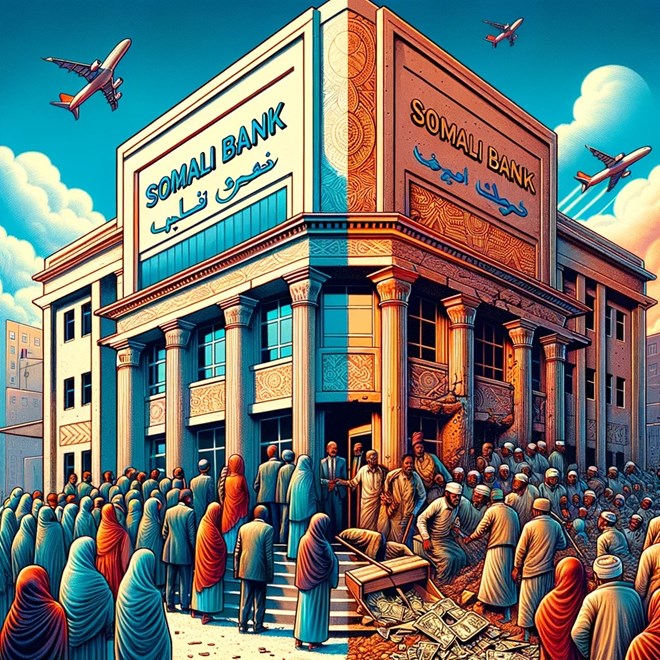Tuesday April 16, 2024
By Hussein Abdullahi Yusuf


This illustration portrays a financial dichotomy. It contrasts the robust confidence of a flourishing fictitious' SOMALI BANK', signifying a period of stability and prosperity, against the despairing scene of a dilapidated banking facade following a bank run, marking an era of economic hardship. Image credit: Hiiraan Online
The Somali financial sector comprises 13 licensed Commercial Banks, 4 Mobile Money Operators, and 2 International banks that cater to client deposits. However, the country faces a notable challenge in bank account penetration, with the rate at a mere 8.3% [1]. This figure starkly contrasts the average account penetration of 43% [2]observed across Africa, highlighting a significant disparity and limited accessibility to banking products in Somalia.
Despite the presence of financial institutions, public trust in the banking sector is relatively low due to, among other things, the lack of deposit insurance or guarantees for customer savings and deposits. This skepticism is evident in the modest total cash within Somali financial institutions, amounting to USD 476.1 million in 2022[3] compared to the substantial USD 6.47 billion [4] held by Kenyan banks. Consequently, many Somalis prefer to retain their funds in informal forms and mobile money accounts.
Moreover, the absence of transparent financial statements and ratios for banks further contributes to customer uncertainty. Without insights into the financial health and stress tolerance of these institutions, clients opt for informal cash storage methods rather than depositing funds in banks, intensifying the challenge of low bank account penetration in Somalia.
This prevailing trend of limited deposits severely hampers the ability of Somali financial institutions to extend credit to the private sector. In 2022, credit extension in Somalia amounted to USD 399.7 million [5], significantly lower than the USD 21.7 billion [6] lent by Kenyan banks during the same period. The disparity in credit extension underscores the critical need for measures to enhance confidence in the financial sector and encourage deposit mobilization.
Unlike EAC countries, deposits are insured up to UGX 10 Million [7] and KSh 500k [8] in Uganda and Kenya, respectively. Somalia initiated the Financial Institution Law in 2012 to establish a Deposit Protection Fund under the supervision of the Central Bank of Somalia (CBS). The primary objective of this fund is to safeguard the stability of Somalia's financial system and protect depositors against potential risks.
Implementing and effectively operating the Deposit Protection Fund would yield several notable benefits, including:
1. Boosting Public Confidence: The establishment and assurance of deposit safety by the fund would foster confidence among the public, encouraging higher levels of deposit mobilization. During financial crises, customers can rely on the safety of their deposits, alleviating the need for immediate withdrawals and mitigating the risk of bank runs. Notably, the extension of deposit insurance to 100% by the Federal Deposit Insurance Corporation in 2023 in response to the USA regional banking crises effectively curtailed significant customer withdrawals, safeguarding the financial system from systemic risks.
2. Enhancing credit disbursement plays a vital role in stimulating economic growth, particularly within the private sector. As banks accumulate customer deposits, they gain the capacity to provide credit to businesses and individuals, fostering investment, entrepreneurship, and expansion. This inflow of credit empowers the private sector to fuel economic activities, generate employment opportunities, and drive overall economic prosperity by supporting innovation and productivity across various industries.
3. Enhancing Financial Inclusion: A robust deposit insurance mechanism would promote greater bank account penetration, facilitating financial inclusivity and access to banking services for a broader segment of the population.
4. Facilitating Business Growth: Establishing Somalia as a secure financial hub for Somali business communities in the region would attract deposits and investments, positioning the country as a key economic center in the East African and Middle Eastern markets.
The lack of a comprehensive deposit insurance mechanism heightens the risk of potential bank runs in Somalia, posing a significant threat to the stability of the financial sector. Therefore, urgent measures are essential to establish and operationalize an effective depositor protection framework to safeguard depositor funds, foster financial stability, and support sustainable economic growth in Somalia.
Hussein Abdullahi Yusuf,
Consultant, Economist and Financial Sector Analyst in Eastern Africa and MENA.
Contacts
Email: [email protected]
Facebook: https://www.facebook.com/profile.php?id=100069787405612&mibextid=ZbWKwL
X: https://twitter.com/HusseinAYusuf2
References:
1- SNBS, 2022. "SOMALIA INTEGRATED HOUSEHOLD BUDGET SURVEY (SIHBS), Feb 2023, Page 70".
2- World Economic Forum, 2023. "Here's why Africa is the world leader in digital and mobile banking"
3- World Bank, 2023. Somalia Economic Update, page 12.
4- Central Bank of Kenya, 2023 "ANNUAL REPORT AND FINANCIAL STATEMENTS 2022/2023".
5- World Bank, 2023. "Somalia Economic Update, page 12".
6- Central Bank of Kenya, 2023 "ANNUAL REPORT AND FINANCIAL STATEMENTS 2022/2023".
7- Deposit Protection Fund of Uganda (DPF). https://dpf.or.ug/
8- Kenya Deposit Insurance Corporation. https://kdic.go.ke/deposit-insurance#:~:text=Conditions%20for%20payout,all%20types%20of%20deposit%20accounts.